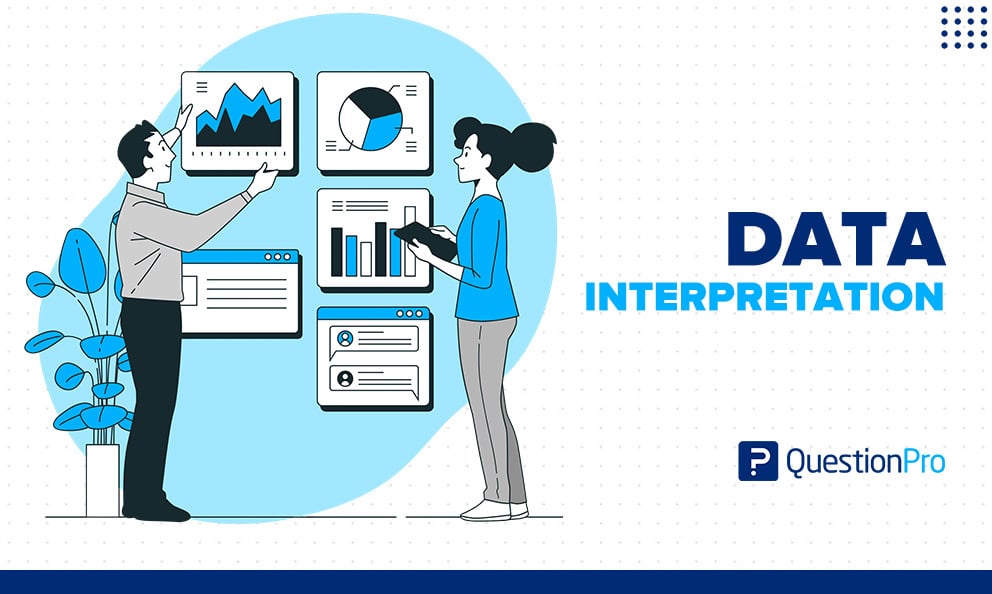
A good data interpretation process is key to making your data usable. It will help you make sure you’re drawing the correct conclusions and acting on your information.
No matter what, data is everywhere in the modern world. There are two groups and organizations: those drowning in data or not using it appropriately and those benefiting.
In this blog, you will learn the definition of data interpretation and its primary steps and examples.
What is Data Interpretation
Data interpretation is the process of reviewing data and arriving at relevant conclusions using various analytical research methods. Data analysis assists researchers in categorizing, manipulating data, and summarizing data to answer critical questions.
LEARN ABOUT: Level of Analysis
In business terms, the interpretation of data is the execution of various processes. This process analyzes and revises data to gain insights and recognize emerging patterns and behaviors. These conclusions will assist you as a manager in making an informed decision based on numbers while having all of the facts at your disposal.
Importance of Data Interpretation
Raw data is useless unless it’s interpreted. Data interpretation is important to businesses and people. The collected data helps make informed decisions.
Make better decisions
Any decision is based on the information that is available at the time. People used to think that many diseases were caused by bad blood, which was one of the four humors. So, the solution was to get rid of the bad blood. We now know that things like viruses, bacteria, and immune responses can cause illness and can act accordingly.
In the same way, when you know how to collect and understand data well, you can make better decisions. You can confidently choose a path for your organization or even your life instead of working with assumptions.
The most important thing is to follow a transparent process to reduce mistakes and tiredness when making decisions.
Find trends and take action
Another practical use of data interpretation is to get ahead of trends before they reach their peak. Some people have made a living by researching industries, spotting trends, and then making big bets on them.
LEARN ABOUT: Action Research
With the proper data interpretations and a little bit of work, you can catch the start of trends and use them to help your business or yourself grow.
Better resource allocation
The last importance of data interpretation we will discuss is the ability to use people, tools, money, etc., more efficiently. For example, If you know via strong data interpretation that a market is underserved, you’ll go after it with more energy and win.
In the same way, you may find out that a market you thought was a good fit is actually bad. This could be because the market is too big for your products to serve, there is too much competition, or something else.
No matter what, you can move the resources you need faster and better to get better results.
What are the steps in interpreting data?
Here are some steps to interpreting data correctly.
-
Gather the data
The very first step in data interpretation is gathering all relevant data. You can do this by first visualizing it in a bar, graph, or pie chart. This step aims to analyze the data accurately and without bias. Now is the time to recall how you conducted your research.
Here are two question patterns that will help you to understand better.
- Were there any flaws or changes that occurred during the data collection process?
- Have you saved any observatory notes or indicators?
You can proceed to the next stage when you have all of your data.
- Develop your discoveries
This is a summary of your findings. Here, you thoroughly examine the data to identify trends, patterns, or behavior. If you are researching a group of people using a sample population, this is the section where you examine behavioral patterns. You can compare these deductions to previous data sets, similar data sets, or general hypotheses in your industry. This step’s goal is to compare these deductions before drawing any conclusions.
- Draw Conclusions
After you’ve developed your findings from your data sets, you can draw conclusions based on your discovered trends. Your findings should address the questions that prompted your research. If they do not respond, inquire about why; it may produce additional research or questions.
LEARN ABOUT: Research Process Steps
- Give recommendations
The interpretation procedure of data comes to a close with this stage. Every research conclusion must include a recommendation. As recommendations are a summary of your findings and conclusions, they should be brief. There are only two options for recommendations; you can either recommend a course of action or suggest additional research.
Data interpretation examples
Here are two examples of data interpretations to help you understand it better:
Example 1
Let’s say your users fall into four age groups. So a company can see which age group likes their content or product. Based on bar charts or pie charts, they can develop a marketing strategy to reach uninvolved groups or an outreach strategy to grow their core user base.
Example 2
Another example of data analysis is the use of recruitment CRM by businesses. They utilize it to find candidates, track their progress, and manage their entire hiring process to determine how they can better automate their workflow.
Conclusion
Overall, data interpretation is an essential factor in data-driven decision-making. It should be performed on a regular basis as part of an iterative interpretation process. Investors, developers, and sales and acquisition professionals can benefit from routine data interpretation. It is what you do with those insights that determine the success of your business.
Contact QuestionPro experts if you need assistance conducting research or creating a data analysis. We can walk you through the process and help you make the most of your data.







